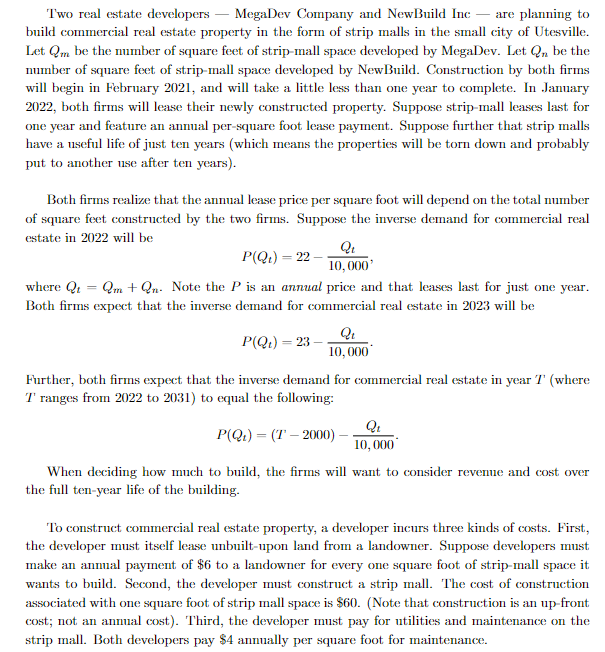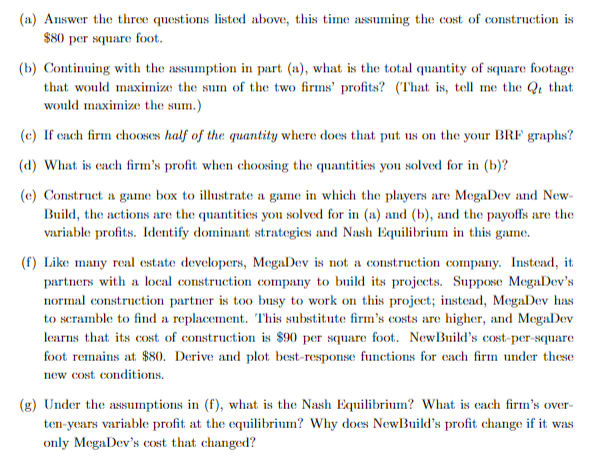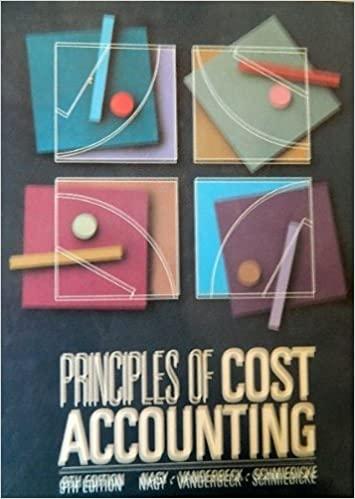

Two real estate developers MegaDev Company and NewBuild Inc are planning to build commercial real estate property in the form of strip malls in the small city of Utesville. Let Qm be the number of square feet of strip-mall space developed by MegaDev. Let On be the number of square feet of strip-mall space developed by New Build. Construction by both firms will begin in February 2021, and will take a little less than one year to complete. In January 2022, both firms will lease their newly constructed property. Suppose strip-mall leases last for one year and feature an annual per-square foot lease payment. Suppose further that strip malls have a useful life of just ten years (which means the properties will be torn down and probably put to another use after ten years). Both firms realize that the annual lease price per square foot will depend on the total number of square feet constructed by the two firms. Suppose the inverse demand for commercial real estate in 2022 will be P(Q) = 22 10,000 where Q1 = Qm+ Qr. Note the P is an annual price and that leases last for just one year. Both firms expect that the inverse demand for commercial real estate in 2023 will be Q P(Qc) = 23 10,000 Further, both firms expect that the inverse demand for commercial real estate in year T (where T ranges from 2022 to 2031) to equal the following: P(QE) = (T-2000) Q: 10,000 When deciding how much to build, the firms will want to consider revenue and cost over the full ten-year life of the building. To construct commercial real estate property, a developer incurs three kinds of costs. First, the developer must itself lease unbuilt-upon land from a landowner. Suppose developers must make an annual payment of $6 to a landowner for every one square foot of strip-mall space it wants to build. Second, the developer must construct a strip mall. The cost of construction associated with one square foot of strip mall space is $60. (Note that construction is an up-front cost; not an annual cost). Third, the developer must pay for utilities and maintenance on the strip mall. Both developers pay $4 annually per square foot for maintenance. (a) Answer the three questions listed above, this time assuming the cost of construction is $80 per square foot. (b) Continuing with the assumption in part (a), what is the total quantity of square footage that would maximize the sum of the two firms profits? (That is, tell me the Qt that would maximize the sum.) (c) If each firm chooses half of the quantity where does that put us on the your BRF graphs? (a) What is each firm's profit when choosing the quantities you solved for in (b)? (e) Construct a game box to illustrate a game in which the players are MegaDev and New Build, the actions are the quantities you solved for in (a) and (b), and the payoffs are the variable profits. Identify dominant strategies and Nash Equilibrium in this game. (f) Like many real estate developers, MegaDev is not a construction company. Instead, it partners with a local construction company to build its projects. Suppose MegaDev's normal construction partner is too busy to work on this project; instead, MegaDev has to scramble to find a replacement. This substitute firm's costs are higher, and MegaDev learns that its cost of construction is $90 per square foot. New Build's cost-per-square foot remains at $80. Derive and plot best-response functions for each firm under these new cost conditions (g) Under the assumptions in (f), what is the Nash Equilibrium? What is each firm's over- ten-years variable profit at the equilibrium? Why does New Build's profit change if it was only MegaDev's cost that changed? C Two real estate developers MegaDev Company and NewBuild Inc are planning to build commercial real estate property in the form of strip malls in the small city of Utesville. Let Qm be the number of square feet of strip-mall space developed by MegaDev. Let On be the number of square feet of strip-mall space developed by New Build. Construction by both firms will begin in February 2021, and will take a little less than one year to complete. In January 2022, both firms will lease their newly constructed property. Suppose strip-mall leases last for one year and feature an annual per-square foot lease payment. Suppose further that strip malls have a useful life of just ten years (which means the properties will be torn down and probably put to another use after ten years). Both firms realize that the annual lease price per square foot will depend on the total number of square feet constructed by the two firms. Suppose the inverse demand for commercial real estate in 2022 will be P(Q) = 22 10,000 where Q1 = Qm+ Qr. Note the P is an annual price and that leases last for just one year. Both firms expect that the inverse demand for commercial real estate in 2023 will be Q P(Qc) = 23 10,000 Further, both firms expect that the inverse demand for commercial real estate in year T (where T ranges from 2022 to 2031) to equal the following: P(QE) = (T-2000) Q: 10,000 When deciding how much to build, the firms will want to consider revenue and cost over the full ten-year life of the building. To construct commercial real estate property, a developer incurs three kinds of costs. First, the developer must itself lease unbuilt-upon land from a landowner. Suppose developers must make an annual payment of $6 to a landowner for every one square foot of strip-mall space it wants to build. Second, the developer must construct a strip mall. The cost of construction associated with one square foot of strip mall space is $60. (Note that construction is an up-front cost; not an annual cost). Third, the developer must pay for utilities and maintenance on the strip mall. Both developers pay $4 annually per square foot for maintenance. (a) Answer the three questions listed above, this time assuming the cost of construction is $80 per square foot. (b) Continuing with the assumption in part (a), what is the total quantity of square footage that would maximize the sum of the two firms profits? (That is, tell me the Qt that would maximize the sum.) (c) If each firm chooses half of the quantity where does that put us on the your BRF graphs? (a) What is each firm's profit when choosing the quantities you solved for in (b)? (e) Construct a game box to illustrate a game in which the players are MegaDev and New Build, the actions are the quantities you solved for in (a) and (b), and the payoffs are the variable profits. Identify dominant strategies and Nash Equilibrium in this game. (f) Like many real estate developers, MegaDev is not a construction company. Instead, it partners with a local construction company to build its projects. Suppose MegaDev's normal construction partner is too busy to work on this project; instead, MegaDev has to scramble to find a replacement. This substitute firm's costs are higher, and MegaDev learns that its cost of construction is $90 per square foot. New Build's cost-per-square foot remains at $80. Derive and plot best-response functions for each firm under these new cost conditions (g) Under the assumptions in (f), what is the Nash Equilibrium? What is each firm's over- ten-years variable profit at the equilibrium? Why does New Build's profit change if it was only MegaDev's cost that changed? C








